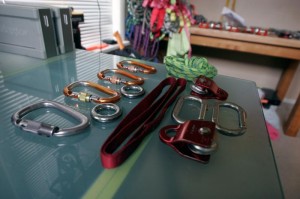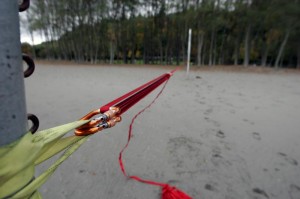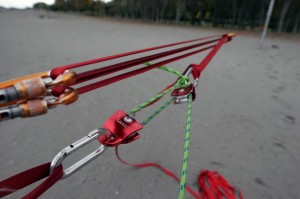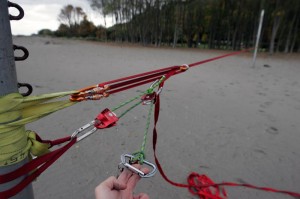Strength of 3 men, for only $20
All of you should be familiar with the basic “Ellington” or “primitive” system. It uses 4 carabiners: 1 to hold the end of the line to one anchor; 1 hitched or line-locked about 80% of the distance from that anchor; 2 more at the other anchor, and a very ‘primitive’ looping of the remaining 20% of webbing distance to act as mechanical advantage. It’s the system I describe in this post. You can build a primitive setup for about $40-60 at REI.Lately I’ve been trick-lining a lot, which means I want my lines super tight, and with summer over there aren’t as many people around to help me pull them tight. So I built a cheap “real” pulley system to act as a multiplier on top of the mechanical advantage of the 3:1 carabiner setup, so that I can put 800lbs of tension* into the line by myself (and I’m only 155lbs!). (*note: this was measured in April 2010 with a calibrated dynomometer and I was able to pull 450lbs using just the 3:1, and 788 using the 3:1 primitive with a pulley multiplier added on)
 The left half of this pic (4 locking carabiners + 2 rappel rings) is my normal “primitive” system. The right half of the pic (60cm red sling, 2 pulleys, 7mm cordolette, 2 black diamond carabiners) is my “strength of 3 men” multiplier.
The left half of this pic (4 locking carabiners + 2 rappel rings) is my normal “primitive” system. The right half of the pic (60cm red sling, 2 pulleys, 7mm cordolette, 2 black diamond carabiners) is my “strength of 3 men” multiplier.
You can buy cheap petzl plastic pulleys for as little as $3.95 at REI (you need 2), or metal mini-pulleys from SMC or CAMP for as little as $13-15. At least 10-15 feet of accessory cord for around $9-14. And of course, two oval carabiners for $6/each. (Total: $29.00 – 55.00)
Alright. So now that we’ve bought our goodies. The setup to the left should look familiar.  This is a 4 carabiner + 2 line locker “primitive” setup. If I have taught you to slackline, or helped you build a kit, this is what you should own. The last two images (below) are an oval + pulley + 12 feet of cord.
This is a 4 carabiner + 2 line locker “primitive” setup. If I have taught you to slackline, or helped you build a kit, this is what you should own. The last two images (below) are an oval + pulley + 12 feet of cord.
THE SETUP
1: Hitch (clove or girth) the first carabiner to the “tail” of the line, right where it comes out of the first tightening system and then clip on the pulley (you’ll use this in step 3).
2: Run the cord to the anchor, through the second pulley (attached to the anchor somehow — either clipped onto the 2 carabiners there, clipped into the anchor sling, or clipped into a second sling like I have done).
3: Run the cord back to the first pulley, through it, and then pull.
The only downside with this setup is that every pull or two you have to “reset” the location of the carabiner that is attached to the tail. Also, you will likely find that the cord (if it’s 6mm or 7mm) is very “sharp” and hurts your hands to pull. This can be fixed by either wrapping it around a stick/rock/whatever, or a spare carabiner. In the last pic, you’ll see that I keep my keys on a 23Kn CAMP carabiner, so when pulling taut I just use this as a “handle”.



How do you tie off the line with this setup? Do you just tie the tail end of the main line in between the 3 carabiner cam system? Furthermore, what is the max line length that this set up can be safely used for?
EDIT: you can take the pulleys out and tie the tail off like normal (I do a few wraps and then tie a hitch), or leave the pulleys in and tie the cord off (same deal). I would say you could easily rig up to 70-80ft by yourself. Anything beyond that will be tough as I usually need more than 3 people to pull tight an 80+ft line (and this pulley setup is really just multiplying your strength by 2-3x).
You should mention that you don’t need the pulleys and the extra rope to make this multiplier. Especially with shorter lengths you just need 2 extra biners and some extra webbing to do the same exact thing.
EDIT: this is true. Not as efficient, but it does work. I’ll do a video comparing both soon!
How do you attach the petzl plastic pulleys to the system? Also, would you advise against using them for any particular reason? Thanks in advance for your help. This website is awesome by the way.
EDIT: I don’t like the Petzl plastic pulleys as the cord tends to slip off of them, but they work if you are careful.
So say if I only have one pulley, can I possibly tie off the cord to the pole and thread the cord through the pulley on the line, and setup the rest of the system the same and have a 2:1 multiplier on hand, instead of your 3:1?
EDIT: you can, but it won’t be very efficient. Unless you use a 3″ pulley (more efficient, especially ball-bearing ones), I doubt it would add any overall benefit to the system. I can test this with a dynomometer to be sure, if you want.
Thanks so much for your help on so many different slacklining topics. I was curious, do these pulleys actually undergo much force? If i’m understanding correctly, they basically only take the force of your pulling on them since the line locks every time you let go of the pulley. I just want to make sure I don’t purchase pulleys that are too weak. Thanks so much.
-Connor
ANSWER: This particular setup, no, the pulleys undergo minimal force (approx 1KN, they are rated for 10-20KN). Your understanding is correct. Any climbing pulley should be sufficiently strong.
it’s called a Martin spike hitch not a girth hitch.
EDIT FROM ADAM: …um, no, it’s not. I think you mean “marlin spike hitch” and assuming you do, that is a distinctly different knot from the girth hitch. But really, why should we worry about what I am calling it, since girth hitch is clearly not an incorrect term (google it and look at the images). I am sure it has other names. It’s a simple hitch that works. Jeez.